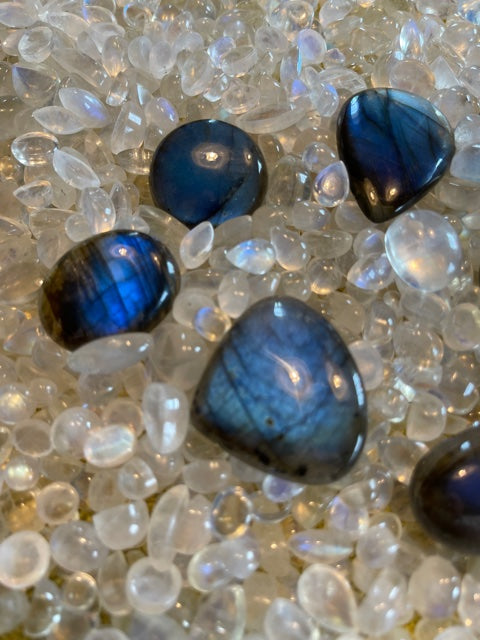Labradorite and Moonstone Jewelry

Labradorite and Moonstone Jewelry
Both labradorite and moonstone are gemstones that are part of the feldspar group of minerals. Although feldspars are among some of the most abundant minerals found in the earth’s crust, only a small fraction are gem quality. In addition to labradorite and moonstone, feldspar gems include amethyst, citrine, sunstone, amazonite, chalcedony, aventurine, rose quartz, and others. While feldspar gemstones have a similar chemistry to one another and may feature similar qualities, they have different crystal structures that cause their unique traits.
Both labradorite and moonstone have long been popular gems, but they’re enjoying a tremendous upsurge in demand recently because of their transformative appearance that reflects change in color and sheen as light plays on the gems. The two gems are quite distinct, however, with the exception of rainbow moonstone, which is technically a labradorite. Hence, some of the confusion between these two types of gemstones. Here, we’ll explore each of these gems in detail, providing an overview of their unusual traits and why humans continue to be so fascinated by them--even after thousands of years.
About Feldspar Gems
All feldspar gems score between a 6 and 6.5 on the Mohs scale of mineral hardness. The abundance of feldspar in the earth’s crust is fortunate, as it’s used for many industrial purposes today, including glass making. Gem-quality feldspar, of course, is more rare and is highly sought after by gem collectors and jewelry lovers. There are three types of feldspars that most feldspar gems fall into. These are:
- Orthoclase feldspar (which includes moonstone)
- Plagioclase feldspar (which includes labradorite)
- Microcline feldspar (which includes amazonite)
Many kinds of feldspar gems are found in isolated deposits. Such gems are not only prized for their beauty, but also their rarity.
Labradorite: An Overview
Labradorite gems come in a wide range of sizes and shapes; however, they tend to be gray, blue, white, or even translucent in color. However, what makes these gems so unique is their Schiller effect (also known as labradorescence). The Schiller effect refers to the color mix that results with the gem’s interaction with light. Light can reveal a dazzling range of hues that seem to glow and radiate iridescent properties. It’s not uncommon for labradorite with this effect to appear in various shades of blues, greens, silver, and gold. Not all labradorite stones will exhibit the Schiller effect, but those that do are most often used to create jewelry and are priced for this rare quality.

Where Is Labradorite Mined?
Labradorite was first discovered in Canada--in Labrador to be specific--and it takes its name, of course, from this location. However, labradorite is also found in various other locations around the world, including Australia, Madagascar, China, Finland, Norway, and the United States. Labradorite is most commonly found in igneous rocks such as basalt and gabbro.
Labradorite Cut and Clarity
Labradorite that appears opaque or translucent is often featured on a black background, which intensifies the gem’s distinctive appearance and enhances its unique color play. Typically, gem cutters will feature labradorite as a round shape or with a domed surface, which also enhances its play of colors. It can be incredibly tricky to cut labradorite because of its transforming properties, so it’s often best left to experienced gem cutters who enjoy working with it.
Labradorite Lore
Many people are not only attracted to labradorite for its beauty and unique traits, but also for its metaphysical properties and the lore associated with it. For instance, labradorite is sometimes called a “stone of mysticism.” Perhaps owing to where it’s found in the north (in places like Canada and Finland), labradorite has been associated with the nature phenomenon aurora borealis, a.k.a. The Northern Lights.
According to Inuit legend, parts of the aurora borealis lights became trapped in the stone, and a warrior struck the stones to free the light so it could return to the sky. Not surprising, labradorite is frequently associated with Inuit shaman tales and rituals. The 18th century missionaries who ‘discovered’ labradorite brought the stones with them to Europe and spread tales of its mystical properties.
Some people believe the labradorite can endow its wearers with feelings of peace and tranquility. Consequently, it’s sometimes offered as a gift to people going through highly stressful life events or situations. With its transforming appearance, labradorite is also popularly worn by individuals who are undergoing dramatic changes in their lives like ending / beginning a new relationship, starting a new career, or changing their lifestyle in some way.
Moonstone: An Overview
Moonstone has long captivated gem enthusiasts all over the world with its glowing qualities and ethereal aura. Moonstone often reveals flashes of color that seem to appear and disappear of their own accord. Moonstone gets its otherworldly glow from a process known as adularescence. Adularescence occurs when light is scattered between the moonstone’s microscopic layers. Consequently, its glow seems to appear just below its surface. Some labradorite (i.e. rainbow moonstone) and sanidine can also demonstrate an adularescent effect. Occasionally, moonstone can even reveal a cat’s eye effect, and such gems are especially collectible. 
Moonstone is generally colorless, has a pale sheen, or is sometimes slightly yellow in hue. Moonstone can also appear blue, green, pink, and peach. While many jewelry designers, especially the renowned Art Nouveau designer Rene Lalique, favor the opaque and colorless or blue moonstone gems, other colors are also featured in jewelry today.
Where Is Moonstone Found?
According to the American Gem Trade Association, the best gem-quality moonstone is found in Southern India and Sri Lanka. Moonstone is also mined in Brazil, Australia, Mexico, Armenia, Myanmar, Austria, Poland, and the United States.
Cut and Clarity
The best moonstone is typically nearly transparent and will contain no or very few inclusions. Though frequently shaped into beads, moonstone is often cut into cabochons or even featured with facets. The cut of moonstone can heighten its brilliance. If inclusions are present in the moonstone, they typically appear like thin ‘centipede’ like strands. Historically, the rose cut was most often favored for moonstone.
In both the past and present, designers used moonstone to create dazzling cameos or intaglios. Carved moonstone continues to be a popular jewelry design. The stone’s softness makes it a good choice for carving.
Moonstone Lore
With their ethereal glow, moonstone has long been associated with celestial properties. For instance, ancient Romans believed that these gems contained solidified moonlight. Both the ancient Greeks and Romans associated moonstone with their lunar deities. Ancient Hindu people also admired the lunar qualities of the gem. They believe that moonstone was contained in the head of their moon deity. Other cultures believe that moonstone can bring clairvoyance and luck.
Moonstone is an alternative birthstone for people born in June (pearl is the traditional birthstone for the month). It’s not uncommon for people to wear moonstone in the belief that it may help them attract abundance in their life and good fortune. According to other historic lore, people sometimes wore moonstone in order to attract love; they believed its powers of attraction were most potent when the moon was out.
Sailors favored moonstone because they thought it could protect them at sea. Moonstone has been referred to as “traveler’s stone” because of this belief. In parts of Asia, some cultures place special significance on blue moonstones; they believe that the tides wash them from the sea to the land only every 21 years.
Gifts of Labradorite and Moonstone Jewelry
As you have read, these gemstones have been popularly worn in jewelry for centuries. Best-quality labradorite and moonstone can make extraordinary gifts for people who love the unique qualities of the gems like their adularence and distinctive color play. Today, it’s easy to find labradorite and moonstone jewelry designed by skilled artisans who create jewels like pendants, rings, earrings, necklaces, and more.
If you know that someone is experiencing a great transition in their lives or under stress, either of these gems may offer some relief--if nothing more than to please the recipient! If you choose to offer them a gift of these gems, be sure to include a description of their properties and the unique lore that’s associated with them.
Jewelry Gifts from Onobird
Onobird has crafted distinctive artisan-quality jewelry for more than 20 years. Many of their designs have featured labradorite and moonstone. Its designers obtain quality gemstones from all over the world to create their captivating jewelry designs. Most of the jewels are set in .925 silver and are handcrafted for one-of-a-kind distinction. When shopping Onobird, you’ll find many stunning jewelry pieces made with turquoise, amethyst, lapis lazuli, jasper, coral, and even sea glass. Visit Onobird today and discover its enchanting jewelry designs that make extraordinary gifts for friends, family, and even yourself! Be sure to visit the website often to find out about its latest additions to its collections!

Leave a comment